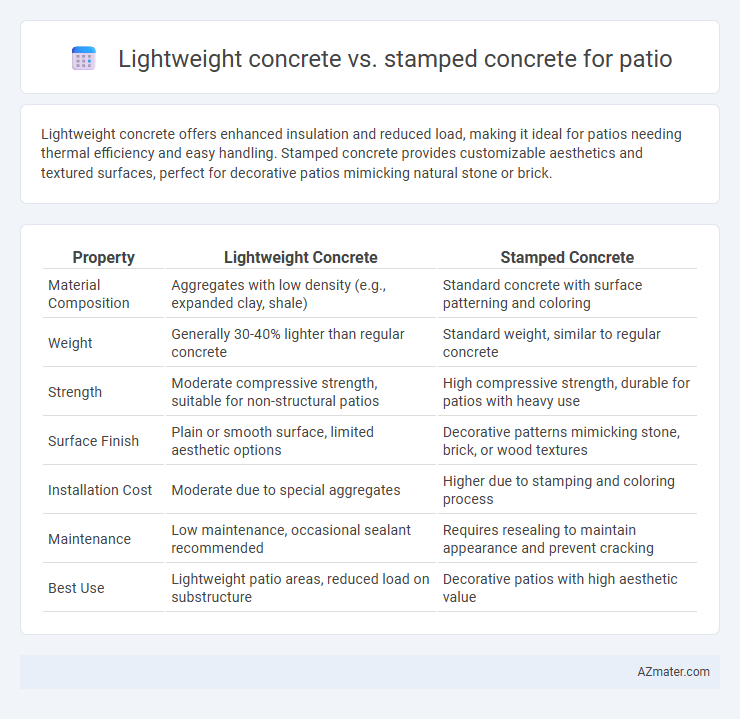Lightweight concrete offers enhanced insulation and reduced load, making it ideal for patios needing thermal efficiency and easy handling. Stamped concrete provides customizable aesthetics and textured surfaces, perfect for decorative patios mimicking natural stone or brick.
Table of Comparison
| Property | Lightweight Concrete | Stamped Concrete |
|---|---|---|
| Material Composition | Aggregates with low density (e.g., expanded clay, shale) | Standard concrete with surface patterning and coloring |
| Weight | Generally 30-40% lighter than regular concrete | Standard weight, similar to regular concrete |
| Strength | Moderate compressive strength, suitable for non-structural patios | High compressive strength, durable for patios with heavy use |
| Surface Finish | Plain or smooth surface, limited aesthetic options | Decorative patterns mimicking stone, brick, or wood textures |
| Installation Cost | Moderate due to special aggregates | Higher due to stamping and coloring process |
| Maintenance | Low maintenance, occasional sealant recommended | Requires resealing to maintain appearance and prevent cracking |
| Best Use | Lightweight patio areas, reduced load on substructure | Decorative patios with high aesthetic value |
Introduction to Lightweight Concrete and Stamped Concrete
Lightweight concrete for patios utilizes expanded clay, shale, or slate aggregates to reduce density while maintaining strength and durability, making it an excellent choice for areas requiring less load-bearing capacity. Stamped concrete mimics natural stone, brick, or slate through textured molds and acid staining or dyes, offering aesthetic versatility and a visually appealing surface. Both materials provide durable options, with lightweight concrete excelling in thermal insulation and ease of handling, while stamped concrete focuses on customization and decorative finishes for outdoor living spaces.
Key Differences Between Lightweight and Stamped Concrete
Lightweight concrete offers superior insulation and reduced structural load, making it ideal for patios requiring durability with less weight, while stamped concrete excels in aesthetic versatility with customizable patterns and textures to mimic natural stone or brick. Lightweight concrete typically has lower compressive strength compared to stamped concrete, which may affect long-term wear depending on usage intensity. Cost variations arise as lightweight concrete often involves specialized materials and mixing processes, whereas stamped concrete requires skilled labor for precise pattern application and sealing.
Material Composition and Properties
Lightweight concrete for patios consists of expanded clay, shale, or slate aggregates, resulting in reduced density and enhanced insulation properties compared to traditional concrete. Stamped concrete is composed of a standard concrete mix combined with color hardeners and release agents to mimic natural stone, brick, or wood textures while maintaining durability and surface strength. Lightweight concrete provides superior thermal efficiency and easier handling due to its lower weight, whereas stamped concrete excels in aesthetic versatility and surface detailing with robust compressive strength.
Installation Process Comparison
Lightweight concrete installation for patios involves mixing lightweight aggregates such as expanded shale or clay, resulting in easier handling and faster placement due to reduced material weight. Stamped concrete requires a meticulous process of pouring, leveling, and impressing textured patterns while the concrete is still wet, necessitating skilled labor for proper timing and pattern alignment. Lightweight concrete tends to expedite installation with simplified curing, whereas stamped concrete demands extended finishing time to achieve the desired decorative effects.
Durability and Longevity
Lightweight concrete for patios offers enhanced durability against cracking and settling due to its reduced weight and superior insulating properties, leading to a longer lifespan in varying weather conditions. Stamped concrete provides aesthetic versatility but may require more maintenance and sealing to preserve its surface against wear, sunlight, and moisture, potentially affecting its long-term durability. For long-lasting patios, lightweight concrete ensures structural resilience, while stamped concrete demands regular upkeep to maintain its appearance and durability.
Design Versatility and Aesthetics
Lightweight concrete offers superior design versatility for patios due to its ease of shaping and molding into intricate patterns and textures, allowing for unique aesthetic finishes. Stamped concrete excels in replicating natural materials like stone, brick, or wood with high detail and color variety, creating visually appealing surfaces that enhance outdoor spaces. Both materials provide customizable options, but lightweight concrete allows for more innovative forms while stamped concrete delivers realistic, textured appearances.
Maintenance Requirements
Lightweight concrete patios require minimal maintenance due to their resistance to cracking and lower weight stress, making them ideal for areas with shifting soil. Stamped concrete demands more upkeep to preserve its decorative patterns and colors, including regular sealing to prevent fading and surface damage. Both options benefit from periodic cleaning, but stamped concrete's intricate design necessitates additional care to maintain its aesthetic appeal over time.
Cost and Budget Considerations
Lightweight concrete typically costs more per cubic yard than stamped concrete due to specialized aggregates and mix design but offers long-term savings through reduced structural support needs. Stamped concrete provides a more budget-friendly initial investment with versatile aesthetics, making it popular for patios where cost control is essential. Choosing between these options depends on balancing upfront material expenses against durability and maintenance budget considerations.
Environmental Impact and Sustainability
Lightweight concrete for patios offers lower embodied energy due to reduced raw material use and improved thermal insulation, decreasing energy consumption for temperature regulation. Stamped concrete typically requires more cement and chemical sealants, increasing carbon footprint and potential VOC emissions. Choosing lightweight concrete supports sustainability goals by minimizing environmental impact while maintaining durability and aesthetic appeal.
Choosing the Best Option for Your Patio
Lightweight concrete offers excellent thermal insulation and reduced load on patio foundations, making it ideal for elevated or structurally sensitive areas. Stamped concrete provides versatile design options with textured surface patterns that mimic natural stone, brick, or wood, enhancing aesthetic appeal. Choosing the best option depends on balancing structural requirements and desired visual impact for your patio project.

Infographic: Lightweight concrete vs Stamped concrete for Patio
 azmater.com
azmater.com